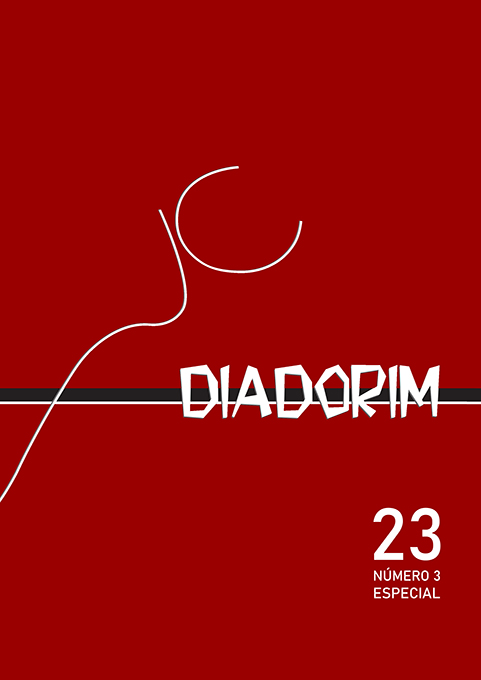[DAR ruim] AND [DAR bom]: two idiosyncratic idioms from brazilian portuguese
DOI:
https://doi.org/10.35520/diadorim.2021.v23n3a45691Palavras-chave:
[DAR bom], [DAR ruim], Brazilian idioms, Usage-Based Linguistics.Resumo
Dar is a Portuguese verb used prototypically in the prepositional dative construction, e.g.: ele deu um anel de diamantes para a noiva (in English, he gave a diamond ring to his bride). According to Goldberg (1995), in this kind of construction, a transference meaning emerges from the interaction of the following semantic roles and syntactic functions: an agent as the subject, a patient as the direct object and a recipient as the indirect object. Although dar usually recruits NPs or PPs as arguments, likewise the English verb to give, it has been widely used in a very idiosyncratic and idiomatic construction in Brazilian Portuguese, where the verb is followed by the adjectives ruim or bom, e.g.: deu ruim, mas está tudo bem (in English, things went bad, but everything is fine). In this paper, we aim to describe this construction, which we represent with the following notation: [DAR ADJ]. Our analysis is based on the theoretical assumptions of Usage-Based Linguistics (cf. ROSÁRIO & OLIVEIRA, 2016; BYBEE, 2010; TRAUGOTT & TROUSDALE, 2013; among others.), especially on the notion of construction as a symbolic form-meaning pairing and on the property of partial/non-compositionality. A total of 200 tokens of [DAR bom] and [DAR ruim] were selected from Corpus Now and analyzed through a quali-quantitative study. The results show that both constructions have been used in argumentative and intersubjective contexts (cf. TANTUCCI, 2018) for evaluative reasons. Moreover, [DAR ruim] is more productive than [DAR bom]: while the word string composed by verb + ruim always instantiate the construction [DAR ADJ] in the corpus, the string composed by verb + bom is more likely to instantiate a more compositional construction – [DAR][NP] –, where the adjective belongs to a NP: e.g., o padre deveria dar [bom exemplo] (in English, the priest could give a [good example]).Referências
BORBA, F. S. Dicionário Gramatical de Verbos do Português Contemporâneo do Brasil. São Paulo: Editora Unesp, 1990.
BYBEE, J. Language, Usage and Cognition. New York: Cambridge University Press, 2010.
CROFT, W. Radical Construction Grammar. New York: Oxford University Press, 2001.
DIESSEL, H. The Grammar Network. How Linguistic Structure is Shaped by Language Use. New York: Cambridge University Press, 2019.
FILLMORE, C. J.; KAY, P.; O’CONNOR, M. C Regularity and Idiomaticity in Grammatical Constructions: The Case of Let Alone. Language, vol. 64, p. 501-538, 1988.
GOLDBERG, A. A Construction Grammar Approach to Argument Structure. Chicago: The University of Chicago Press, 1995.
_____. Constructions at Work. The Nature of Generalization in Language. New York: Oxford University Press, 2006.
HILPERT, M. Construction Grammar and its Application to English. Edinburgh: Edinburgh University Press, 2014.
HIMMELMANN, N. P. Lexicalization and grammaticization: Opposite or orthogonal? In BISANG, W; HIMMELMANN, N. P; WIEMER, B (eds). What Makes Grammaticalization: A Look from its componentes and its fringes. Berlin: De Gruyter, 2004, p. 21-42.
MATTOSO CÂMARA Jr., J. Princípios de Linguística Geral. 4ª. ed. Rio de Janeiro: Livraria Acadêmica, 1967.
ROSÁRIO, I. C; OLIVEIRA, M. R. Funcionalismo e abordagem constructional da gramática. Revista Alfa, v. 2, n. 60. São Paulo, p. 233-259, 2016.
TANTUCCI, V. From Co-Actionality to Extended Intersubjectivity: drawing on Language Change and Ontogenetic Development. Applied Linguistics, p. 1-31, 2018.
TAYLOR, J. R. The Mental Corpus: How Language is Represented in the Mind. Oxford: Oxford University Press, 2012.
TRAUGOTT, E. C. (Inter)subjectivity and (inter)subjectification: a reassessment. In: DAVIDSE, K; VANDELANOTTE, L; CUYCKENS. Subjectification, Intersubjectification and Grammaticalization. Belgium: De Gruyter, 2010, p. 1-42.
TRAUGOTT, E. C; TROUSDALE, G. Constructionalization and Constructional Changes. New York: Oxford University Press, 2013.
Downloads
Publicado
Edição
Seção
Licença
Transferência de direitos autorais - Autorização para publicação
Caso o artigo submetido seja aprovado para publicação, já fica acordado que o autor autoriza a UFRJ a reproduzi-lo e publicá-lo na Diadorim: Revista de Estudos Linguísticos e Literários, entendendo-se os termos "reprodução" e "publicação" conforme definição respectivamente dos incisos VI e I do artigo 5° da Lei 9610/98. O artigo poderá ser acessado pela internet, a título gratuito, para consulta e reprodução de exemplar do artigo para uso próprio de quem a consulta. Essa autorização de publicação não tem limitação de tempo, ficando a UFRJ responsável pela manutenção da identificação do autor do artigo.

A Revista Diadorim utiliza uma Licença Creative Commons Atribuição-NãoComercial 4.0 Internacional (CC BY-NC 4.0).

